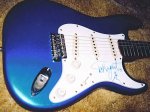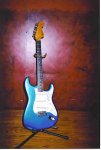pisces7378
New member
I have a bright red Fender Stratocaster that I bought around 1984-85. It was my first real electric guitar besides two or three $200 student jobbies.
I have bought several guitars since then, (Gibson ES-335, Telecaster, Gibson SJ-200, Ibanez 12-string, Fender Prodogy [bad guitar]) etc. So the old strat kind of fell by the waste side, and basically sat in it's case in my old bedroom at my parent's house for 4 years while I lived in Europe. When I got back...
...the tremelo system was all rusted up, the pickups are pretty rusted on the little magnet dots, the tuning keys are a little jangly and rusted. And I had just remembered how much I HATED the "1980's hair on fire fuck-me-I'm-a-rock-star Fire engine red color that it is. And so I shoved it under my bed in my new apt.
Then a year later after my band and I were playing steady shows here and there... my other guitars had problems... so I broke out the old Strat. It sounds SOOOOO much better than I remember it sounding. Even through all the rust it still sounds descent. Some paint nicks, and rust... but the neck is great and the electronics (knob pots, input jack, and switch) are a little crackly and all but nothing HORRIBLE.
Any-damn-way... I want to fix this puppy up. Starting with the color. I know that it is all vain, and cosmetic to worry about paint. But we play real sweet indi-vintage type stuff (think: "The Band and Crazy Horse" backing up "The Jesus and Mary Chain") all originals. It just fucks with me to be up there playing a piece of lip-stick.
So I have a few questions. How do I go about getting it re-painted. Is this something that I could do myself AT ALL??? Or is that a "Hell No!" with a capitol "Hell"? If I have to get some local guitar repair man to do it for me, how much am I looking at?
What about WD Music Productions ? They sell already finished Strat style bodies for around $225. I don't want anything fancy. Just a solid black strat body. If I have to pay some dude $200 to re-paint it, then I would just as soon buy a new body for it for $225. But then what happens when I try to sell it later (should that day come). Would I be like commiting fraud to call it a Fender Stratocaster? I mean, the neck and electronics, and all the gear would be Fender stuff, but the body would be a WD. Or are WD's somehow accredited by Fender to be sold as "Fender Bodies"?
Anyway this thread is way too long already. What do you guys think I should do?
I have bought several guitars since then, (Gibson ES-335, Telecaster, Gibson SJ-200, Ibanez 12-string, Fender Prodogy [bad guitar]) etc. So the old strat kind of fell by the waste side, and basically sat in it's case in my old bedroom at my parent's house for 4 years while I lived in Europe. When I got back...
...the tremelo system was all rusted up, the pickups are pretty rusted on the little magnet dots, the tuning keys are a little jangly and rusted. And I had just remembered how much I HATED the "1980's hair on fire fuck-me-I'm-a-rock-star Fire engine red color that it is. And so I shoved it under my bed in my new apt.
Then a year later after my band and I were playing steady shows here and there... my other guitars had problems... so I broke out the old Strat. It sounds SOOOOO much better than I remember it sounding. Even through all the rust it still sounds descent. Some paint nicks, and rust... but the neck is great and the electronics (knob pots, input jack, and switch) are a little crackly and all but nothing HORRIBLE.
Any-damn-way... I want to fix this puppy up. Starting with the color. I know that it is all vain, and cosmetic to worry about paint. But we play real sweet indi-vintage type stuff (think: "The Band and Crazy Horse" backing up "The Jesus and Mary Chain") all originals. It just fucks with me to be up there playing a piece of lip-stick.
So I have a few questions. How do I go about getting it re-painted. Is this something that I could do myself AT ALL??? Or is that a "Hell No!" with a capitol "Hell"? If I have to get some local guitar repair man to do it for me, how much am I looking at?
What about WD Music Productions ? They sell already finished Strat style bodies for around $225. I don't want anything fancy. Just a solid black strat body. If I have to pay some dude $200 to re-paint it, then I would just as soon buy a new body for it for $225. But then what happens when I try to sell it later (should that day come). Would I be like commiting fraud to call it a Fender Stratocaster? I mean, the neck and electronics, and all the gear would be Fender stuff, but the body would be a WD. Or are WD's somehow accredited by Fender to be sold as "Fender Bodies"?
Anyway this thread is way too long already. What do you guys think I should do?


 so much for mexican quality control.
so much for mexican quality control.
